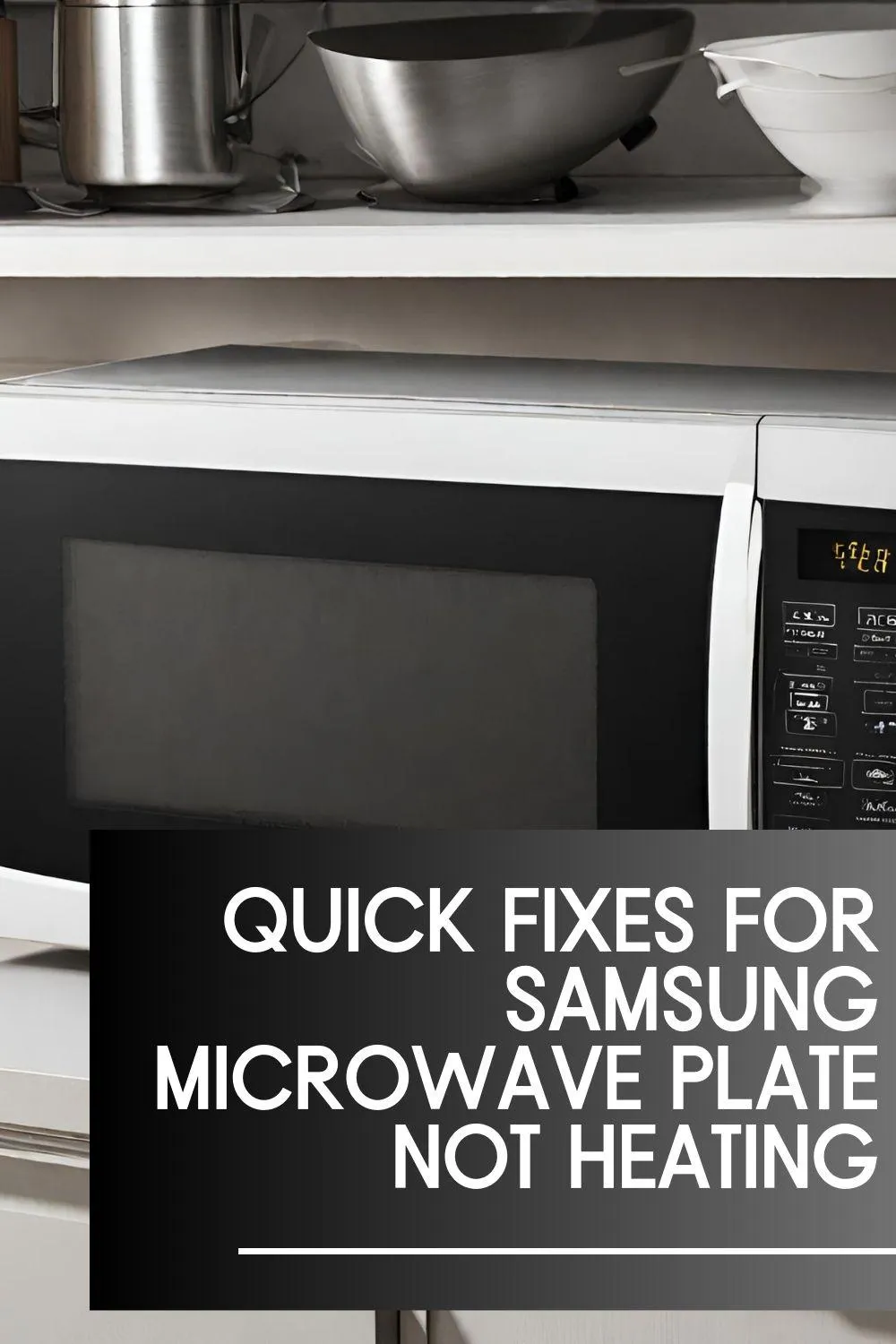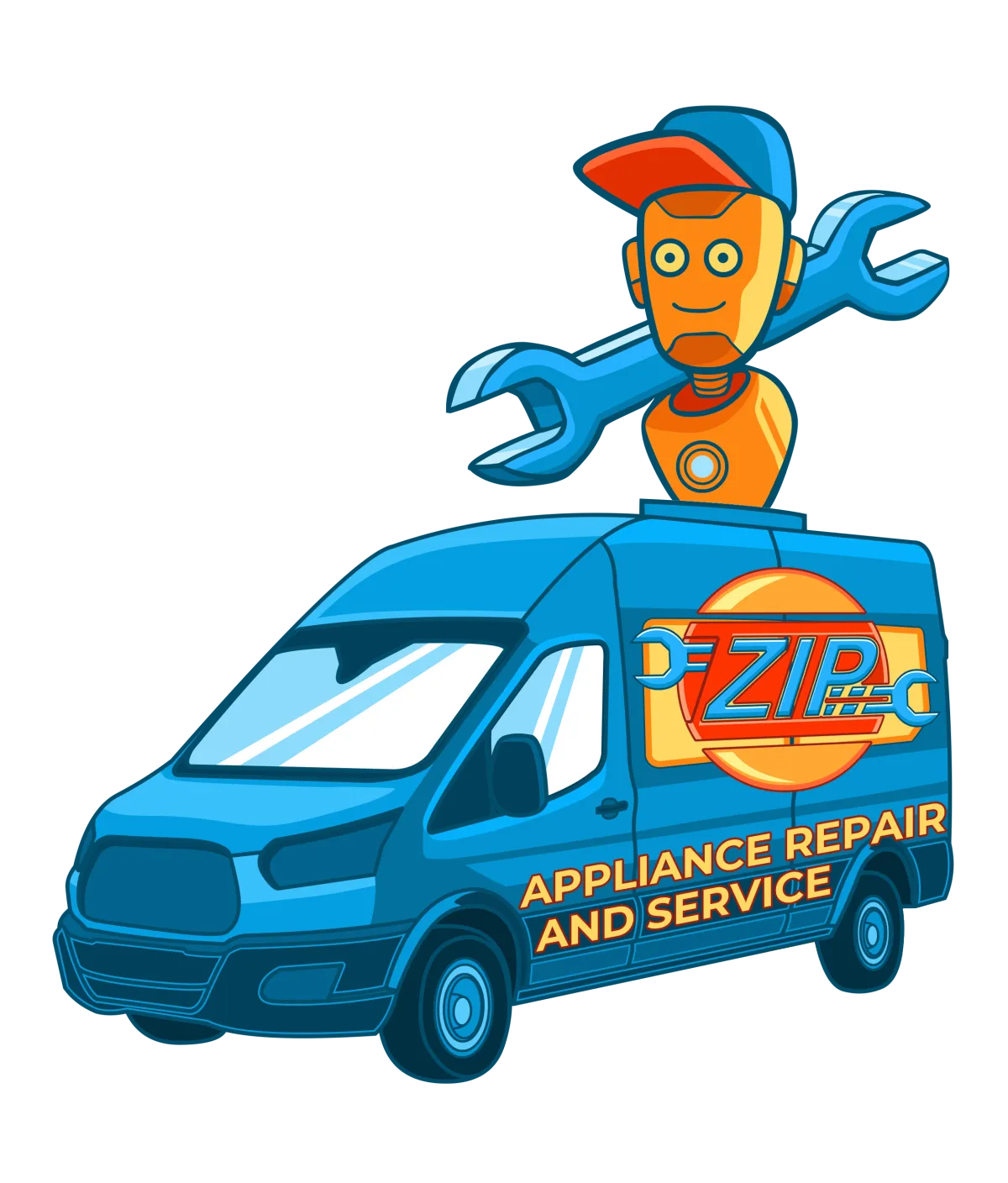Phone: (559) 272-4265
Appliance Repair Tips For Bakersfield, CA Residents

Troubleshooting Guide: Samsung Microwave Plate Not Heating
Quick Fixes for Samsung Microwave Plate Not Heating
Introduction:
Welcome to the Troubleshooting Guide for Samsung Microwave Plate Not Heating
Microwaves have become indispensable kitchen appliances, but encountering a non-heating plate can be frustrating. Whether you're trying to warm up leftovers or cook a quick meal, the inability of your microwave to heat the plate can throw a wrench into your plans. In this comprehensive guide, we'll delve into the reasons behind a non-heating microwave plate and provide you with practical solutions to address the issue.
Understanding the frustration of a non-heating microwave plate
Imagine preparing your favorite meal, eagerly anticipating its warm embrace, only to find that your microwave isn't cooperating. The frustration is real, and we understand the inconvenience it can cause in your daily routine. From soggy leftovers to cold breakfasts, a non-heating microwave plate can disrupt your culinary endeavors and leave you scratching your head.

Importance of addressing the issue promptly
Addressing the issue promptly is crucial for several reasons. Not only does it ensure that you can continue enjoying the convenience of your microwave, but it also prevents the problem from escalating into a more significant issue. By taking action early, you can save yourself time, money, and the hassle of dealing with a malfunctioning appliance.
Common Causes of Microwave Plate Not Heating
Overview of potential reasons behind the problem
There are several potential reasons why your microwave plate may not be heating as it should. Understanding these underlying issues is the first step towards finding a solution and restoring your microwave's functionality.
Lack of power supply
Sometimes, the simplest explanation is the most likely culprit. If your microwave isn't receiving power from the outlet, it won't be able to generate the heat necessary to warm up your food.
Faulty heating element
The heating element is responsible for producing the heat that warms up your food. If it's damaged or malfunctioning, your microwave may struggle to heat the plate properly.
Malfunctioning control panel
The control panel serves as the command center for your microwave, allowing you to adjust settings and start the cooking process. If it's not functioning correctly, it can disrupt the microwave's ability to heat the plate.
Door switch issues
The door switch is a safety feature that prevents the microwave from operating when the door is open. If it's not working properly, it may prevent the microwave from heating the plate even when the door is closed.
Diagnosing the Problem
Step-by-step instructions for assessing the microwave's condition
To troubleshoot the issue effectively, you'll need to follow a systematic approach to assess the condition of your microwave and identify the root cause of the problem.
Checking power source and outlet
Start by ensuring that the microwave is plugged in and that the outlet is supplying power. You can do this by plugging in another appliance or using a multimeter to test the outlet.
Inspecting the heating element
Next, inspect the heating element for any signs of damage or wear. Look for cracks, breaks, or discoloration that may indicate a problem.
Testing the control panel functionality
Test each function of the control panel to ensure that it's responding correctly to your inputs. If any buttons are unresponsive or if the display is malfunctioning, it may indicate an issue with the control panel.
Evaluating the door switch mechanism
Finally, check the door switch mechanism to ensure that it's engaging properly when the door is closed and disengaging when the door is open. If the switch is stuck or damaged, it may prevent the microwave from heating the plate.
Tools Needed for Troubleshooting
Essential tools for diagnosing and fixing the issue
Having the right tools on hand is essential for effectively diagnosing and fixing the issue with your microwave. Here are a few tools you may need:
Multimeter for electrical testing
A multimeter is a versatile tool that can be used to test the electrical components of your microwave, such as the power supply and heating element.
Screwdriver for accessing internal components
You'll need a screwdriver to remove the casing of the microwave and access its internal components for inspection and repair.
Microwave-safe container for testing heating
To test the microwave's heating functionality, you'll need a microwave-safe container filled with water. This will allow you to determine whether the microwave is able to generate heat effectively.
Safety Precautions
Importance of safety when working with electrical appliances
Safety should always be your top priority when working with electrical appliances. Here are a few safety precautions to keep in mind:
Unplugging the microwave before inspection
Before you begin any inspection or repair work, make sure to unplug the microwave from the power source to prevent electric shock.
Using insulated tools to prevent electric shock
When working with electrical components, use insulated tools to reduce the risk of electric shock. This will help protect you from injury and ensure your safety while troubleshooting the microwave.
Avoiding contact with internal components when the microwave is plugged in
Never attempt to inspect or repair the internal components of the microwave while it's plugged in. This can increase the risk of electric shock and serious injury. Always unplug the microwave before working on it.
Fixing the Issue: Step-by-Step Guide
Detailed instructions for resolving the problem
Once you've diagnosed the issue with your microwave, it's time to take action to fix it. Here's a step-by-step guide to help you address the problem and restore your microwave's functionality:
Resetting the circuit breaker or fuse
If the microwave isn't receiving power, start by checking the circuit breaker or fuse box and resetting any tripped breakers or replacing blown fuses.
Replacing the heating element
If the heating element is damaged or faulty, you'll need to replace it to restore proper heating functionality to the microwave. This may require disassembling the microwave and installing a new heating element.
Repairing or replacing the control panel
If the control panel is malfunctioning, you may be able to repair it by cleaning or replacing individual components. If the damage is more severe, you may need to replace the entire control panel to restore functionality to the microwave.
Adjusting or replacing the door switch
If the door switch isn't engaging properly, you may need to adjust it to ensure proper operation. If the switch is damaged or worn out, you'll need to replace it with a new one to prevent further issues with the microwave.
Tips for Preventing Future Problems
Proactive measures to maintain microwave functionality
Taking proactive measures to maintain your microwave can help prevent future problems and ensure its longevity. Here are a few tips to keep in mind:
Regular cleaning to prevent debris buildup
Regularly clean the interior and exterior of the microwave to prevent debris buildup that can interfere with its operation. Use a mild detergent and warm water to wipe down the surfaces and remove any food residue or spills.
Avoiding overloading the microwave with heavy dishes
Avoid overloading the microwave with heavy dishes, as this can strain the heating elements and lead to performance issues. Instead, use lightweight dishes and distribute the food evenly to ensure even heating.
Promptly addressing any unusual sounds or smells
If you notice any unusual sounds or smells coming from the microwave during operation, don't ignore them. These may be warning signs of underlying issues that need to be addressed promptly to prevent further damage to the appliance.
Seeking Professional Help
When DIY troubleshooting is not successful
If your DIY troubleshooting efforts aren't successful in resolving the issue with your microwave, it may be time to seek professional help. Here are a few options to consider:
Contacting Samsung customer support for assistance
Samsung customer support can provide valuable assistance with troubleshooting and repairing your microwave. Contact them for guidance if you're unable to resolve the issue on your own.
Hiring a certified technician for repairs
If the issue with your microwave requires professional repairs, consider hiring a certified technician with experience working on Samsung appliances. They'll have the knowledge and expertise to diagnose and fix the problem quickly and effectively.
Conclusion
Recap of key points covered in the troubleshooting guide
In this comprehensive troubleshooting guide, we've covered the common causes of a microwave plate not heating and provided detailed instructions for diagnosing and fixing the problem. From checking the power supply to testing the heating element and control panel, we've walked you through each step of the process to help you get your microwave back up and running.
Encouragement to address the issue promptly for optimal microwave performance
Addressing the issue promptly is essential to ensure the efficient operation of your microwave and avoid prolonged inconvenience in the kitchen. By following the tips and guidelines outlined in this guide, you can troubleshoot and resolve the problem quickly, allowing you to continue enjoying the convenience of your microwave without interruption.
Importance of regular maintenance to prevent future problems
Regular maintenance and proactive measures can help prevent future problems with your microwave and prolong its lifespan, saving you time and money in the long run. By keeping your microwave clean, avoiding overloading it with heavy dishes, and promptly addressing any unusual sounds or smells, you can ensure that it continues to perform optimally for years to come.
For professional assistance with your appliance repair needs, don't hesitate to contact Zip Appliance Repair and Service. Visit our website at www.ziprepairservice.com or give us a call at (661) 387-2282. Our experienced technicians are here to help you get your microwave and other appliances back in top condition.

Troubleshooting Guide: Samsung Microwave Plate Not Heating
Quick Fixes for Samsung Microwave Plate Not Heating
Introduction:
Welcome to the Troubleshooting Guide for Samsung Microwave Plate Not Heating
Microwaves have become indispensable kitchen appliances, but encountering a non-heating plate can be frustrating. Whether you're trying to warm up leftovers or cook a quick meal, the inability of your microwave to heat the plate can throw a wrench into your plans. In this comprehensive guide, we'll delve into the reasons behind a non-heating microwave plate and provide you with practical solutions to address the issue.
Understanding the frustration of a non-heating microwave plate
Imagine preparing your favorite meal, eagerly anticipating its warm embrace, only to find that your microwave isn't cooperating. The frustration is real, and we understand the inconvenience it can cause in your daily routine. From soggy leftovers to cold breakfasts, a non-heating microwave plate can disrupt your culinary endeavors and leave you scratching your head.

Importance of addressing the issue promptly
Addressing the issue promptly is crucial for several reasons. Not only does it ensure that you can continue enjoying the convenience of your microwave, but it also prevents the problem from escalating into a more significant issue. By taking action early, you can save yourself time, money, and the hassle of dealing with a malfunctioning appliance.
Common Causes of Microwave Plate Not Heating
Overview of potential reasons behind the problem
There are several potential reasons why your microwave plate may not be heating as it should. Understanding these underlying issues is the first step towards finding a solution and restoring your microwave's functionality.
Lack of power supply
Sometimes, the simplest explanation is the most likely culprit. If your microwave isn't receiving power from the outlet, it won't be able to generate the heat necessary to warm up your food.
Faulty heating element
The heating element is responsible for producing the heat that warms up your food. If it's damaged or malfunctioning, your microwave may struggle to heat the plate properly.
Malfunctioning control panel
The control panel serves as the command center for your microwave, allowing you to adjust settings and start the cooking process. If it's not functioning correctly, it can disrupt the microwave's ability to heat the plate.
Door switch issues
The door switch is a safety feature that prevents the microwave from operating when the door is open. If it's not working properly, it may prevent the microwave from heating the plate even when the door is closed.
Diagnosing the Problem
Step-by-step instructions for assessing the microwave's condition
To troubleshoot the issue effectively, you'll need to follow a systematic approach to assess the condition of your microwave and identify the root cause of the problem.
Checking power source and outlet
Start by ensuring that the microwave is plugged in and that the outlet is supplying power. You can do this by plugging in another appliance or using a multimeter to test the outlet.
Inspecting the heating element
Next, inspect the heating element for any signs of damage or wear. Look for cracks, breaks, or discoloration that may indicate a problem.
Testing the control panel functionality
Test each function of the control panel to ensure that it's responding correctly to your inputs. If any buttons are unresponsive or if the display is malfunctioning, it may indicate an issue with the control panel.
Evaluating the door switch mechanism
Finally, check the door switch mechanism to ensure that it's engaging properly when the door is closed and disengaging when the door is open. If the switch is stuck or damaged, it may prevent the microwave from heating the plate.
Tools Needed for Troubleshooting
Essential tools for diagnosing and fixing the issue
Having the right tools on hand is essential for effectively diagnosing and fixing the issue with your microwave. Here are a few tools you may need:
Multimeter for electrical testing
A multimeter is a versatile tool that can be used to test the electrical components of your microwave, such as the power supply and heating element.
Screwdriver for accessing internal components
You'll need a screwdriver to remove the casing of the microwave and access its internal components for inspection and repair.
Microwave-safe container for testing heating
To test the microwave's heating functionality, you'll need a microwave-safe container filled with water. This will allow you to determine whether the microwave is able to generate heat effectively.
Safety Precautions
Importance of safety when working with electrical appliances
Safety should always be your top priority when working with electrical appliances. Here are a few safety precautions to keep in mind:
Unplugging the microwave before inspection
Before you begin any inspection or repair work, make sure to unplug the microwave from the power source to prevent electric shock.
Using insulated tools to prevent electric shock
When working with electrical components, use insulated tools to reduce the risk of electric shock. This will help protect you from injury and ensure your safety while troubleshooting the microwave.
Avoiding contact with internal components when the microwave is plugged in
Never attempt to inspect or repair the internal components of the microwave while it's plugged in. This can increase the risk of electric shock and serious injury. Always unplug the microwave before working on it.
Fixing the Issue: Step-by-Step Guide
Detailed instructions for resolving the problem
Once you've diagnosed the issue with your microwave, it's time to take action to fix it. Here's a step-by-step guide to help you address the problem and restore your microwave's functionality:
Resetting the circuit breaker or fuse
If the microwave isn't receiving power, start by checking the circuit breaker or fuse box and resetting any tripped breakers or replacing blown fuses.
Replacing the heating element
If the heating element is damaged or faulty, you'll need to replace it to restore proper heating functionality to the microwave. This may require disassembling the microwave and installing a new heating element.
Repairing or replacing the control panel
If the control panel is malfunctioning, you may be able to repair it by cleaning or replacing individual components. If the damage is more severe, you may need to replace the entire control panel to restore functionality to the microwave.
Adjusting or replacing the door switch
If the door switch isn't engaging properly, you may need to adjust it to ensure proper operation. If the switch is damaged or worn out, you'll need to replace it with a new one to prevent further issues with the microwave.
Tips for Preventing Future Problems
Proactive measures to maintain microwave functionality
Taking proactive measures to maintain your microwave can help prevent future problems and ensure its longevity. Here are a few tips to keep in mind:
Regular cleaning to prevent debris buildup
Regularly clean the interior and exterior of the microwave to prevent debris buildup that can interfere with its operation. Use a mild detergent and warm water to wipe down the surfaces and remove any food residue or spills.
Avoiding overloading the microwave with heavy dishes
Avoid overloading the microwave with heavy dishes, as this can strain the heating elements and lead to performance issues. Instead, use lightweight dishes and distribute the food evenly to ensure even heating.
Promptly addressing any unusual sounds or smells
If you notice any unusual sounds or smells coming from the microwave during operation, don't ignore them. These may be warning signs of underlying issues that need to be addressed promptly to prevent further damage to the appliance.
Seeking Professional Help
When DIY troubleshooting is not successful
If your DIY troubleshooting efforts aren't successful in resolving the issue with your microwave, it may be time to seek professional help. Here are a few options to consider:
Contacting Samsung customer support for assistance
Samsung customer support can provide valuable assistance with troubleshooting and repairing your microwave. Contact them for guidance if you're unable to resolve the issue on your own.
Hiring a certified technician for repairs
If the issue with your microwave requires professional repairs, consider hiring a certified technician with experience working on Samsung appliances. They'll have the knowledge and expertise to diagnose and fix the problem quickly and effectively.
Conclusion
Recap of key points covered in the troubleshooting guide
In this comprehensive troubleshooting guide, we've covered the common causes of a microwave plate not heating and provided detailed instructions for diagnosing and fixing the problem. From checking the power supply to testing the heating element and control panel, we've walked you through each step of the process to help you get your microwave back up and running.
Encouragement to address the issue promptly for optimal microwave performance
Addressing the issue promptly is essential to ensure the efficient operation of your microwave and avoid prolonged inconvenience in the kitchen. By following the tips and guidelines outlined in this guide, you can troubleshoot and resolve the problem quickly, allowing you to continue enjoying the convenience of your microwave without interruption.
Importance of regular maintenance to prevent future problems
Regular maintenance and proactive measures can help prevent future problems with your microwave and prolong its lifespan, saving you time and money in the long run. By keeping your microwave clean, avoiding overloading it with heavy dishes, and promptly addressing any unusual sounds or smells, you can ensure that it continues to perform optimally for years to come.
For professional assistance with your appliance repair needs, don't hesitate to contact Zip Appliance Repair and Service. Visit our website at www.ziprepairservice.com or give us a call at (661) 387-2282. Our experienced technicians are here to help you get your microwave and other appliances back in top condition.
If your dryer has been giving you problems, contact Zip Appliance Repair & Service at (661) 387-2282

Appliance Repair In A Zip
If you need a dryer repair call our Team at (661) 387-2282, or visit our online scheduling page to request service.
Appliance Repair
Plumbing Repair Services
HAVE A QUESTION, CALL (661) 387-2282

Online Offers
Take advantage of our online discount offers - save time and money...

Residential & Commercial appliances
See what our company can do for you

Appliance Repair Tips
If your appliance is not working properly...

1405 Commercial Way ste 100
Bakersfield, CA 93309
Lic # 1116346
Equipment We Sevice
- A Call To Confirm Your Appointment Time
- A Email Detailing Your Assigned Technician
- Information Needed Before The Repair Can Be Started
- An Estimate Of Work To Be Done
© 2025 ZIP APPLIANCE REPAIR & SERVICE LLC








